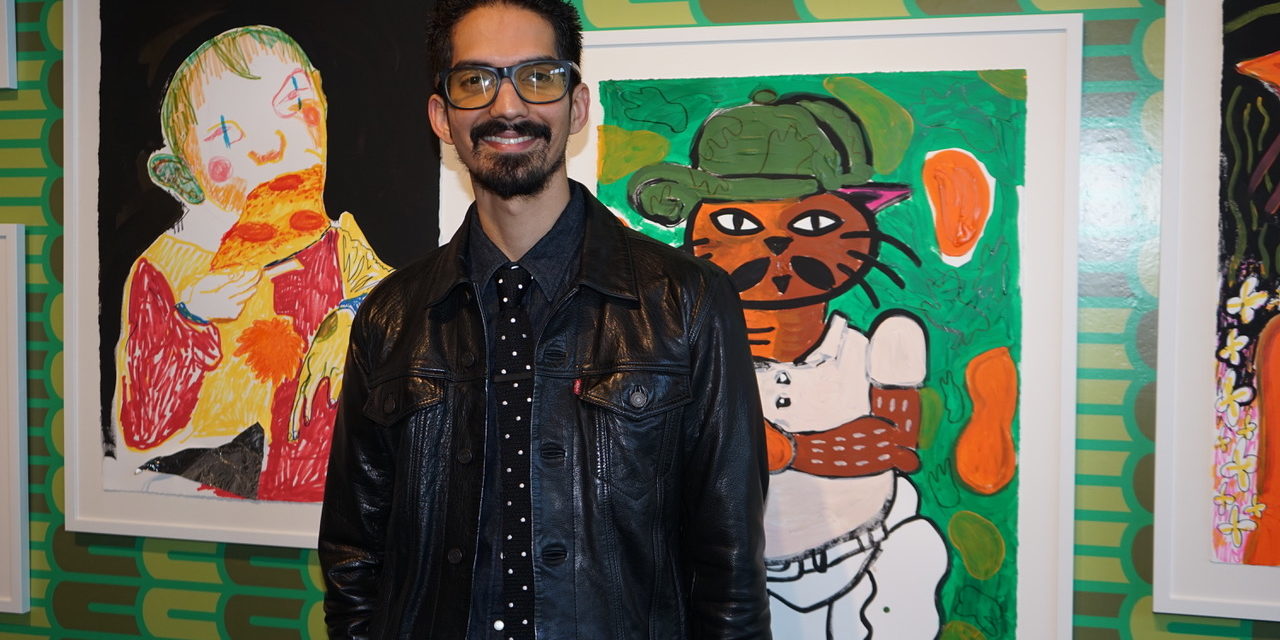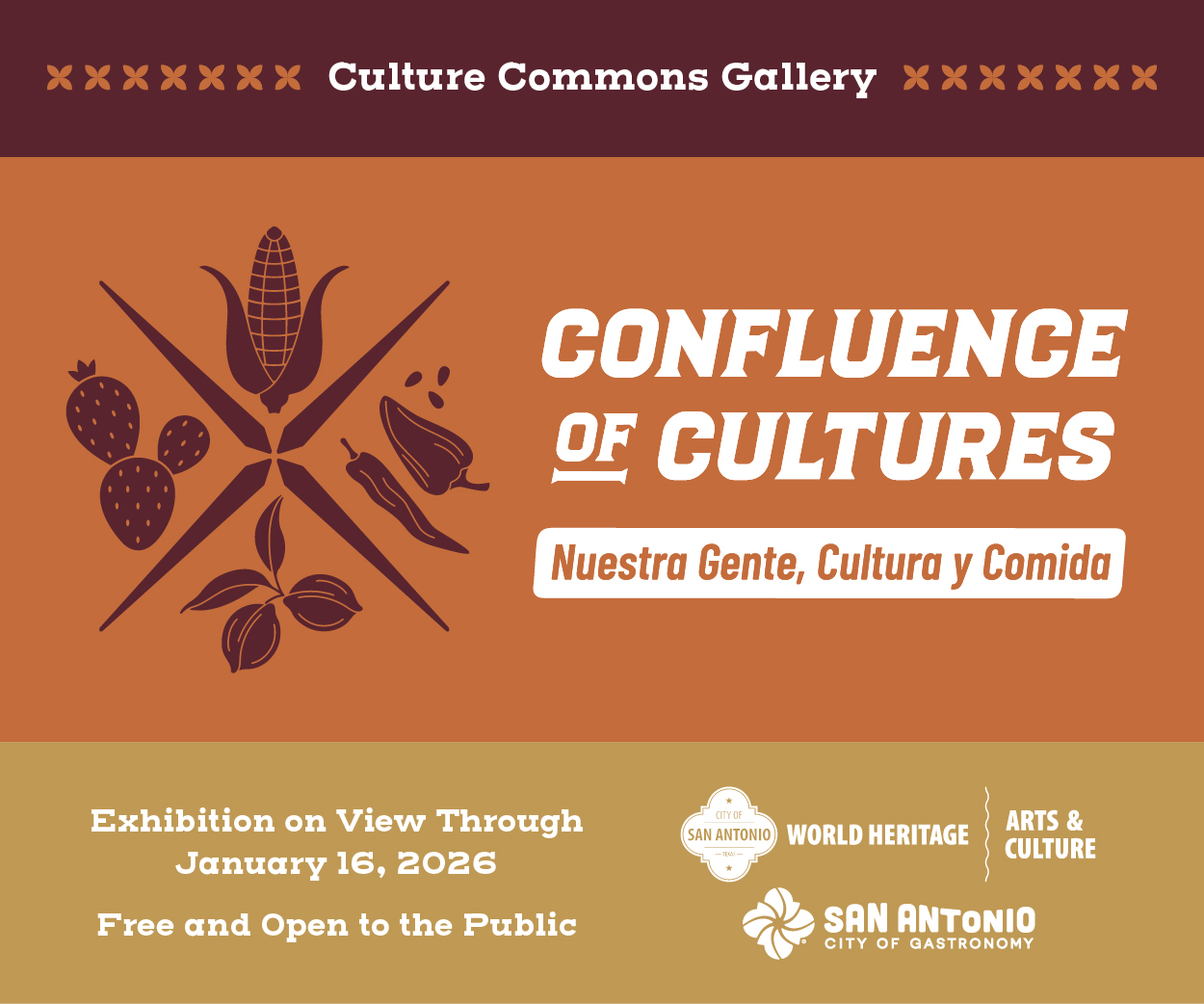Michael Menchaca’s exhi- bition, “100 Years of Print- making in San Antonio: Mi- chael Menchaca,” closes on January 6th and you won’t want to miss it. While Menchaca is known as an exceptional artist in print design, his studies at the prestigious Rhode Island School of Design enabled him to expand into the world of video and digital art. In his new exhibit at the McNay, there are fifty prints and an amazing video. The entrance to the exhibit takes your breath away. There are tall columns wrapped in an intricate black and white paper design representing eagle feathers. To see the exhibit, one en- ters a long hallway with four twenty foot high columns on each side wrapped in the eagle feather printed paper. Inside, all the walls have a similar pattern, for the printed paper serves as a backdrop for his many prints and a colorful and dramatic digital video. Menchaca is especially proud of his video creation which sheds light on the dark world of drug traffickers, the plight of immigrants, and the turmoil of the Trump proposed border wall. His story about immigra- tion is made more complicated by a failure of police on both sides of the border to protect citizens. Menchaca frames his im- ages based on historical events and anthropological interpre- tations. For instance, he makes extensive use of the Mayan and Aztec systems of writ- ing and uses pre Columbian figures and texts common to the Mexican Indian codices. He dramatizes these images and figures in his effort to ad- dress issues on race relations, politics, and social justice. In a print titled “Hasta La Casta,” which is a play on words from the phrase “Hasta La Vista,” Menchaca delves deep into Spanish colonial history following the conquest of Mexico when conquerors created a caste system referred to as “Castas.” In the matrix of castas, there were mestizos, mulatos, Indios, and coyotes, to name a few of the fifty-four racial and ethnic categories. Menchaca includes coyotes and different skin tones to show the blurred boundaries of such categorization. As we learn from the daily news, there is ample human tragedy along the southern border. In new prints se- lected for the McNay exhibit, Menchaca utilizes cats as well as other animals to document the struggles and difficulties that migrants face as they contract coyotes, fight off the narcos, and try to evade apprehension by the Border Patrol. Menchaca strives to pres- ent cultural events through invented mythology. In many of his earlier works, he ac- knowledges using “animal ar- chetypes to tell stories of class inequality, civil rights cases, and the distribution of privi- leges within the Americas.” San Antonians became fa- miliar with Menchaca’s iconic prints following his inclusion in the Estampas De La Raza exhibit at the McNay in 2016. The exhibit included 46 out- standing Latino and Latina artists from across the coun- try, as well as Menchaca’s cats crossing the Rio Grande print. The Estampas exhibit, which traveled to Los Ange- les, Albuquerque, Chicago, and Raleigh, gave Menchaca’s art exposure in regions of America that might have been unfamiliar with his work. The Estampas catalog, published by the Univer- sity of Texas Press, also re- ceived international distribution. In his artist’s statement for the Estampas exhibit, Menchaca noted: “ I try to bring various in- fluences to bear on the imagery…contem- porary cartoons and animation, ancient writing systems, racial identity and humor.” His print, “Cuando El Rio Suena Gatos Lleva,” addressed the issue of Mexican mi- gration to the United States. In this piece, which is included in the current 2018 McNay exhibit, Menchaca’s subjects are portrayed as cats wearing sombreros. They are shown swimming across a wide Rio Grande. In the last several years Menchaca has expanded on his themes and images, add- ing that the cat motif opened “the doors for me to explore my cultural heritage, racial tension, stories of immigra- tion, all with a sense of levity, while formally connecting to the ancient representational traditions of the American continent.” When Dr. Patricia Ruiz- Healy interviewed Menchaca earlier this year at her gallery in Olmos Park, she pressed him on what he saw on the horizon for Chicano artists. A forthcoming publication by Ruiz Healy Gallery offers some insight into Mencha- ca’s current and future work. Menchaca noted that “We must initiate a new wave of Chicano imagery expressing our collective concerns in the present age. We must rise past a reliance on sociological and cultural generalizations regarding Chicano art and insist on more comprehensive art interpretation.” His comments also revealed on-going work that appear in the McNay exhibition. Not- ing that “The Internet is now accepted as an art medium within museums and institu- tions,” he called for Chicano artists to “partake in digital mediums as well as Internet art approaches.” Chicano art is coming of age in America. The Smithsonian will have a major show on Chicano art in 2020. With the exciting Menchaca exhibit along with current exhibits of Pop America and a small exhibit of the work of Mel Ca- sas, the McNay Museum has once again demonstrated an appreciation of art by Chica- nos, Latinos/as, and Mexican Americans. This art has a place every- where in America, but espe- cially in cities like San An- tonio where Latinos make up the majority of the population. Recent Chicano art exhibits in Los Angeles, Chicago, and Houston align with San Antonio in making sure that when we view American art, we see the work of Chicanos included.
The Creative World of Michael Menchaca






